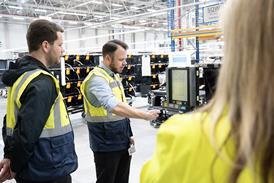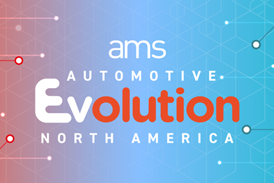Sturm’s chief operating officer, Ralf Völlinger discusses the company's recent installation at BMW Leipzig

Painting system supplier Sturm Group has recently installed a paintshop designed for handling plastic parts for exterior vehicle components at the BMW factory in Leipzig. The required standard of accuracy for the paint finishes is exacting; the painted surfaces have to be finished with a Class-A surface comparable to that of the main car body.
Material handling comprises a mix of both manual and automated procedures. Individual components, which include bumpers, sidewalls and hoods, are transferred manually to the painting holders at the component loading station. The loaded holders are carried on a floor-mounted skid conveyor system through the painting station. As Sturm’s chief operating officer, Ralf Völlinger, points out this simple technique removes the possibility of component contamination from excess paint or lubricants dripping from above, as might occur if using an overhead conveyor.
Since the painting process itself is completely automated each part is assigned its own unique RFID label. According to Völlinger, the essential hardware for completing the painting process comprises 22 robots. Following the robotic process material handling reverts to human operators.
Quality of surface finish is not the sole objective of the installation. Another is the economic use of resources. A deliberate design decision was made not to use a wet-chemical pre-treatment, so as to avoid the generation of waste water. Instead, the components are subjected to an initial cleaning process by blasting with a mixture of frozen carbon dioxide particles and air. Apart from offering excellent cleaning, the carbon dioxide particles revert to a gaseous state after impacting on the components, leaving virtually no residue. Even in light of these benefits, Völlinger says the process is still very unusual in an automotive paintshop environment. The next step sees the surface of each of the components subjected to a robotically controlled flaming process in order to increase its adhesion properties ready for the paint layer.
The three-coat painting process
The painting process comprises the application of three coats: primer, basecoat and clearcoat. Material usage is optimised for environmental and energy efficiency. As such, the primer stage involves the use of water-based paints applied via a highspeed rotary atomiser. Following a short flash-off time, drying takes place in an energy saving A-dryer. The colour layer also utilises a water-based paint system. In order to minimise rinsing losses when changing paint colour a cartridge system is used. Völlinger says that this system has a low rate of paint loss between changes and so a positive effect on the waste balance sheet. The final clearcoat layer consists of a conventional two-component paint system applied by a high-speed rotary atomiser in conjunction with electrostatics.
The painting cabins used for these three stages share common features. All are operated with circulating air, which has been filtered and conditioned to match the requirements for specific painting processes. Völlinger notes that the work process itself determines the quantity of air which needs to be prepared and then disposed of, so that energy consumption is kept to a minimum.
Overspray extraction involves a dry separation system which uses conventional stone powder. As such, there is no need for expensive water treatment or paint sludge extraction procedures. Völlinger points out, the stone powder is also a recyclable material that can be used for other industrial purposes.




























